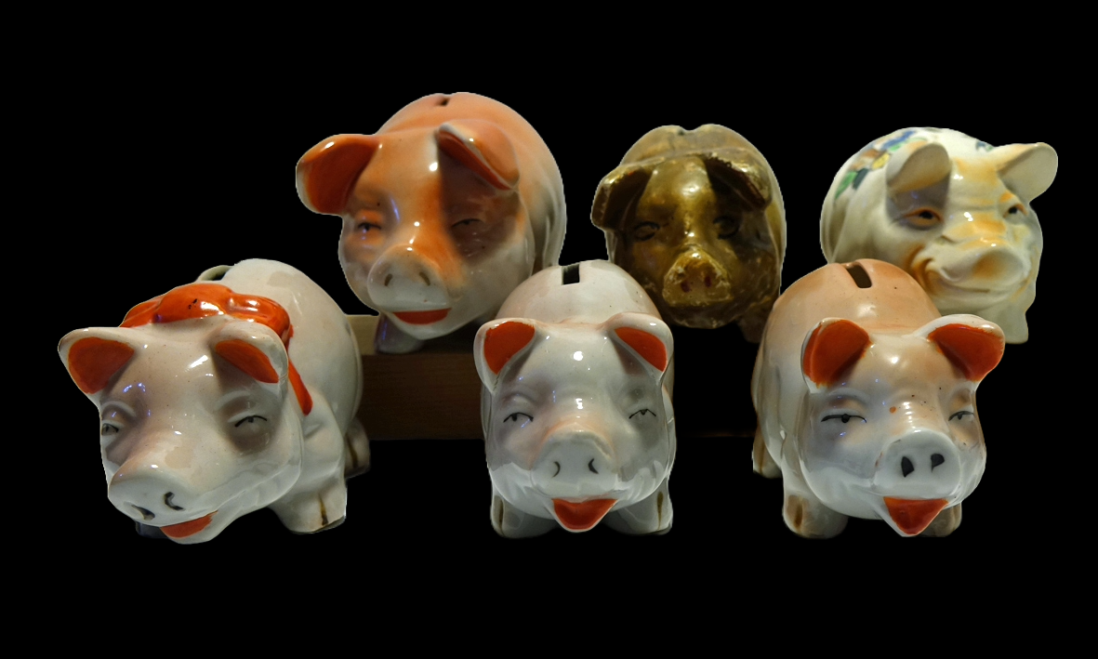RU/ CN/ JP/ ID
Collection 2

Russia (RU), China (CN)/ Japan (JP)/ Indonesia (ID)
Russia
Russian pottery has a rich and fascinating history. The Russian Tsars, especially Catherine the Great, were great admirers of European porcelain, such as that of Meissen in Germany. Catherine the Great ordered similar high-quality porcelain to be produced in Russia, which led to the establishment of several important porcelain factories. The Russian porcelain industry was originally heavily influenced by European styles and techniques, especially those from Germany and France. The tsars and nobility often collected European porcelain, which inspired Russian manufacturers to achieve comparable quality and artistic value.
Major brands are: Lomonosov Porcelain Factory (Imperial Porcelain Factory); Dmitrov State Porcelain Factory (originally Gardner Porcelain Factory, founded in 1766 by English entrepreneur Francis Gardner); Kuznetsov Porcelain Factory; Dulyovo Porcelain Works and important for my piggy bank collection: Gzhel Porcelain Factory and Konakovo Faience Factory.

Made by KONOKOVO Faience. Based on the original mold from the USSR era (used from 1962-1974). Length 20.5 cm.
Beautifully shaped piggy bank from the Gzhel region. It is difficult to distinguish whether the Gzhel rose is hand-painted or a transfer. Length 23.5 cm. No Gzhel brand. A promotional/advertising transfer from "KOM". Until now (08-2025) it is not clear what KOM stands for. Even the chatbots can't figure it out.

China
China, the land of age-old traditions and innovations, is the cradle of porcelain. Chinese craftsmen perfected this delicate art form as early as the Tang Dynasty (618-907), but working with clay goes back much further. They have been making pottery in China since the Neolithic period, about 20,000 years ago, as evidenced by the impressive archaeological finds.In the 17th century, trade relations between China and Europe began to flourish, especially through the Dutch East India Company. Portuguese ships, known as "Kraaken or Caraque", transported valuables such as silk, spices and especially porcelain. "Kraak porcelain" owes its name to these ships and often served as ballast during long sea voyages. This porcelain, with its characteristic blue decorations on a white background, captured the hearts of Europeans and became a symbol of status and refinement. "Chine de Commande" was a special type of porcelain made to order for the European market. Wealthy merchants and aristocrats had unique pieces made with personal motifs, family crests and European scenes. This special exchange of cultures led to remarkable works of art that contained both Eastern and Western influences. Although Dutch Delft Blue is clearly inspired by Chinese blue-white porcelain, it is not a Chinese invention. Dutch artisans developed their own techniques and styles, creating a unique and recognisable product that is still loved today. Chinese pottery and porcelain are more than just utensils; they tell stories of cultural exchanges, trade routes and the evolution of human craftsmanship. Every ceramic piggy bank carries a piece of this rich history. It is a tangible reminder of a civilisation that strove for centuries for perfection in arts and crafts.
As for ceramic money boxes, Chinese potters introduced the first examples during the Ming Dynasty (1368-1644). Often designed as animals, and in particular pigs, they symbolised prosperity, happiness and abundance. These piggy banks were not only functional, but also artistically designed with an eye for detail and symbolism. In my collection are specimens from the years 1948-1955 and recent ones from 2006. None of them have a specific hallmark, the oldest has a label indicating the origin.


Japan
Japan for me is known for its ceramics (such as Imari porcelain), textiles, lacquerware, swords and dolls, the famous tea ceremony, ikebana, martial arts, calligraphy, origami, geisha and games (nowadays such as Nintendo). But do they also have a thing for pigs? And piggy banks? Sure, pigs to start with: Surprisingly, the most popular type of meat in Japan is pork. It finds more sales than beef and chicken combined. This tradition dates back to the days when Japan was a poor and agricultural country. The Samurai named pigs “walking vegetable”. According to history, they owed their legendary strength and stamina to their diet with a large proportion of pork. Of course, Japan also perfected the breeding of pigs. The most acclaimed species is kurobuta. This black pig from Kagoshima is not originally Japanese It is a direct descendant of the Old English black Berkshire breed.
And piggybanks? I know for years that they also make piggy banks and mainly for export. If it “says” "Foreign" under it, they have been exported as a ready-made product, if it says "import" below, it is a semi-finished product that is to be finished in the country that ordered it.
Where I can often trace the provenance of other piggy banks, I have no clue whatsoever for the Japanese piggy banks. They are both kitschy (in not Japanese eyes!), beautiful and most of the piggy banks are made of porcelain!


Indonesia
Trowulan (Java) is surrounded by an archaeological site of the capital city of the Majapahit Empire from the 14th to the 15th century. Excavations have found evidence of dense population during the 14th to 15th centuries. Terracotta figurines, amongst them piggy banks, were produced in large quantities. The Majapahit piggy banks (not for children!) were used to put coins in as offering to the gods. These very thin bronze Chinese coins were found during excavations in large numbers. I have serious doubt about the age of my 5 Majapahit piggy banks: I think they are copies.
Pigs (pig piggy banks) in Indonesia? You have to explain that. The Majapahit was a Hindu-Buddhist empire from c. 1293 to c. 1530, with the centre on East Java, in what is now Indonesia. From the 13th century, Islam very slowly spread across Indonesia. It is believed that with the end of the Majapahit Empire and with the final destruction of the capital in 1527, the production of terracotta was stopped. After all, the sultanates were now ruled by Islamic rulers, and as a result of the Islamic 'image hostility' there was no longer a need for terracotta figures, let alone piggy banks. Much was broken in those days, no wonder that most of the terracotta statues and piggy banks that we can still see are often broken. But much has also been buried in places where rice or tobacco was later grown. And there was found again in the 20th century. What remains of the Majapahit culture has been recognized as heritage and is now on display in and near the Trowulan Museum.

















































